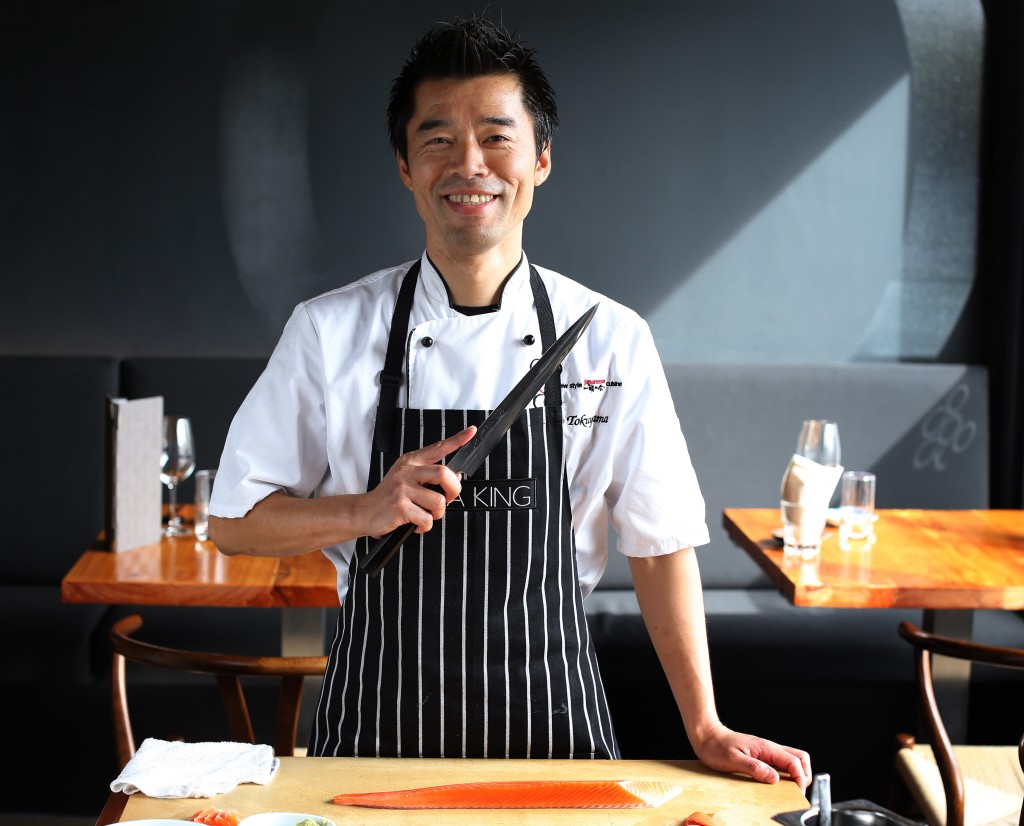Watch ‘how to make Ōra King salmon sashimi’ with Makoto Tokuyama of Auckland’s Cocoro here…
To accompany the video here is a step by step guide from Makoto:
Sashimi is already widely understood as slices of raw fish meat. In the word ‘sashimi’, ‘mi’ means meat, but ‘sashi’ actually means ‘poke’ in English, not ‘slice’ or ‘cut’. This is because in Japan it is taboo to use the word ‘cut’ or ‘slice’ since old times. The word ‘sashi’ (English: ‘poke’) comes from the decoration of such dishes, where a chef would ‘poke’ the fin of the fish as decoration to assemble an image of the live fish.
Fact: The word to ‘cut’ or ‘slice’ in Japanese is highly taboo in Japan due to its linkages or connotations to samurai warriors and the cutting off of people’s heads.
Making sashimi Ōra King: 1. After the salmon is filleted, the next step is to cut into the back loin and belly loin. Then start skinning.
Tip: use salt on the meat, leave for a couple of minutes, then rinse off with water. This is to help clear the fishy smell.
2. Skinning of the salmon should be done so that the skin is taken carefully off, leaving a thin layer of silver skin still on the fillet. This is ideal to achieve as this makes the sashimi more beautiful when presented, and also tastes better, as the silver edge between the skin and the meat has very high umami and nutritional content.
3. Next remove the part of the middle of the back and belly loin. But don’t throw these parts away as they are goods for use in a salmon dish like tartare for example.
Tip: Ōra King salmon can be used in many various ways of cooking, and you can eat all the parts without having to throw away.
4. Now cut the back and belly loins into good sizes for sashimi. The edge of the belly loin, which I have trimmed away, is called ‘Harasu’, this part is very good for ‘aburi’ (seared sashimi or sushi).
Tip: Back loin is used for the sashimi slices and Belly loin is used for the sushi slices.
5. Now we slice the salmon for sashimi and sushi. Sashimi and sushi slices are always cut against the grain. Use one smooth motion as you slice.
6. To cut good sashimi comes down to 2 critical points: 1) having a sharp knife (flat knife required, ideally a sashimi knife), 2) having the index finger placed correctly on knife while cutting. The sashimi knife is designed to cut using the full blade by pulling the knife, and therefore has a long, thin shape. To utilise this, the way to hold the knife becomes very important. The index finger should be straight and firmly pushing onto the back bone of the knife, while the other 4 fingers grip the handle. At the base of the fillet, turn the blade so it stands vertical against the cutting board.
Tip: One of the easiest mistakes that leads to badly cut sashimi pieces is that the index finger is not pushing firmly enough on the knife. When you are pulling the knife to slice the sashimi, focus on that index finger and press firmly, while relaxing the wrist, elbow and shoulder. Then you should find it easy to slice the perfect sashimi.
7. When plating a sashimi dish I imagine the mountains in the Northern Alps of Japan. The sharp cut edges of each piece of sashimi become important, as these edges are placed upwards, just like those mountain edges. One of the most important aspects of ‘Washoku’ – Japanese cuisine, is to express nature, and the natural beauty of Japan in the display of the food.
Tip: Marinate salmon roe (‘ikura’) in soy sauce, sake, mirin, and yuzu to give it a subtle, sweet and salty Japanese flavour, and add this to your sashimi ‘flowers’ as a garnish.
8. The Ōra King salmon has a bright orange flesh, which contrasts with the pure white fat lines, and it has a beautiful texture and aroma, so it makes it easy to express the natural beauty and awesome taste on your plate. It melts in your mouth, yum!


Leave a Reply